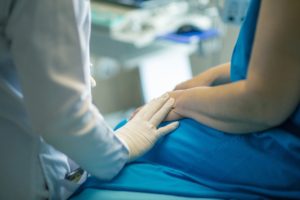Endometriosis Therapy for Infertility
Upon an endometriosis diagnosis, inquiries about the intricate link between endometriosis and the desire to conceive frequently arise. Endometriosis has the potential to impact fertility across various dimensions, often presenting challenges, though not universally, to achieving conception.
The therapy of endometriosis is individually tailored to the primary goal of the therapy. This means that if pain is the predominant symptom, different priorities are set for the therapy than if an unfulfilled desire to have children is the biggest problem. Of course, both can be present at the same time.
If the patient wants to become pregnant as soon as possible, or within the next 6 months, the influence of each potential therapy on pregnancy and a possible fertility therapy must be considered.
Forewarning: Endometriosis does not Automatically Mean Infertility

The stork’s arrival may not always be immediate.
It is vital to recognize that not every woman afflicted by endometriosis faces infertility. While research findings are not entirely definitive, an estimated 30-50% of affected women encounter fertility issues or struggle to realize their parenthood aspirations [1]. Hence, the realm of endometriosis and pregnancy are not inherently exclusive, however, the condition often introduces complexities to the conception journey. It is worth noting that endometriosis does not unilaterally account for unfulfilled fertility desires.
Consequently, when facing unfulfilled hopes for parenthood, a comprehensive investigation, encompassing both partners, is imperative.
Navigating Endometriosis and Fertility: Selecting Optimal Therapies
When considering therapy for endometriosis alongside a desire to conceive, this factor must unquestionably influence the decision-making process. If plans for parenthood are on the horizon, hormonal therapy is not advisable, due to its contraceptive effects and the persistence of endometriosis. For women with potential childbearing aspirations, a preferable approach involves surgical removal of endometriosis lesions (excision) [4]. Nonetheless, even within this framework, the surgical objectives differ when compared to non-fertility-focused cases. Minimizing the necessity for multiple surgeries is prudent when seeking to conceive. In cases where fertility is a concern, infertility treatments can prove beneficial. Integrating a multimodal pain management strategy is also crucial in instances where pain is a prevailing issue.
Strategic Timing of Surgery in Endometriosis and Fertility Aspirations

Surgery can have a positive impact on fertility in endometriosis
Surgical interventions hold the potential for enhancing fertility in the context of endometriosis. Especially as a primary surgical measure, it can yield substantial positive outcomes. For instance, the removal of adhesions or cysts that hinder conception can be instrumental. Through excising endometriosis cysts and minimizing lesions, the factors impeding fertility can be effectively addressed in a comprehensive manner.
Nevertheless, in cases involving deep infiltrating endometriosis with complexities like bowel involvement or other high-risk aspects necessitating extensive surgery and prolonged recovery, full surgical intervention might be deferred. In such scenarios, partial surgical procedures are commonly pursued, followed by fertility treatments. The comprehensive surgical approach is often postponed until after fertility-related treatments are completed. However, this sequencing remains a personalized choice.
Conversely, if the timeline for starting a family extends into the future, a primary focus revolves around the complete removal of endometriosis and the management of associated symptoms.
Crucially, the decision to proceed with surgery is an individualized one. Deliberation with a specialized medical professional after a thorough assessment is imperative for informed choices tailored to unique circumstances.
Appropriate Surgical Approaches for Fertility Preservation
The selection and approach of surgery, particularly when addressing endometriosis cysts on the ovaries, play a pivotal role in preserving a woman’s fertility. Recognizing that surgical procedures themselves can potentially adversely impact the ovaries due to mechanical irritation and tissue damage, surgical treatment for endometriosis aligns with fertility aspirations by minimizing the impact on the ovaries [4] In cases where the desire for childbirth exists, the preservation of ovarian tissue takes precedence, often leading to a cautious approach in removing endometriosis cysts to avoid extensive ovarian tissue removal. This consideration stems from the understanding that heightened surgical manipulation may detrimentally influence the ovarian hormonal environment, resulting in fewer mature eggs being produced. Consequently, this aspect forms an integral consideration in devising endometriosis treatment strategies for individuals aspiring to conceive.
Additionally, as previously mentioned, efforts are directed toward circumventing the need for procedures involving abdominal incisions or artificial anuses. Subsequent surgeries (such as the reversal of the artificial intestinal outlet) or extended recovery periods can impede the timely commencement of fertility treatments or pregnancy, necessitating a thorough individual assessment before determining the most suitable course of action.
Additional Surgical Measures for Fertility Aspirations:

In every instance, the selection of the surgical approach is a personalized decision contingent upon numerous factors.
For those with an unfulfilled desire to conceive, abdominal endoscopy serves as a valuable surgical option. Typically, a uterine endoscopy and a fallopian tube patency evaluation are incorporated into this process. Through the use of a camera, the uterine cavity is visually examined to identify potential anatomical hindrances to successful implantation. Concurrently, minor polyps or uterine septa can be excised during the same procedure.
A blue dye is introduced into the uterus and then flushed into the fallopian tubes to ascertain tubal patency. The subsequent visualization of the leakage of this fluid from the fallopian tubes can be observed through the laparoscopy camera.
Consequently, a single surgical operation can comprehensively address various factors contributing to difficulties in achieving pregnancy, offering both diagnostic insights and potential remedial measures if necessary.
How long do you have to wait to get pregnant after surgery?
If focusing solely on endometriosis, the ideal period for attempting pregnancy post-surgery would be immediate.
Nonetheless, following a laparoscopy, it is recommended to avoid strenuous activities (sports, heavy lifting, etc.) for 4–6 weeks. After a uterine endoscopy, commonly conducted when planning a conception, abstaining from sexual intercourse for 4 weeks is advisable to prevent infections.
Consequently, after the standard procedure for endometriosis and fertility aspirations – a laparoscopy with a tubal patency test and uterine endoscopy – the initial attempt can be initiated after 4 weeks.

Depending on the surgical procedure, a waiting period of up to three months before attempting pregnancy may be advised.
For cases involving abdominal incisions, a common suggestion is to wait 3 months post-surgery before conceiving. However, this duration could be shorter or longer, contingent upon factors like incision size and surgery type. The rationale for this guideline is to allow the abdominal region to heal across all layers, preparing it to withstand the expansion during pregnancy.
A distinct scenario involves the removal of endometriosis lesions in the uterine wall or fibroids during surgery. In these cases, the timing should be personalized and discussed directly with the surgeon.
Regarding endometriosis and the desire for parenthood, it’s essential to engage in individual discussions with the gynecologist. This pertains not only to disease treatment but also to surgical considerations. While laparoscopy is typically preferred over abdominal incision for endometriosis and fertility aspirations, feasibility may vary.
Summary
Endometriosis and the desire to have children are not fundamentally incompatible, although the risk of infertility is elevated, and pregnancy complications are more frequent.

Infertility concerns can often be addressed through personalized treatment plans.
Procedures such as the removal of endometriosis cysts or adhesions can enhance fertility prospects. Concurrent diagnostic and therapeutic actions are commonly integrated during laparoscopic procedures to minimize recovery periods.
Nevertheless, the approach taken should be tailored in consultation with the treating physician. Even after successful surgery, assisted reproductive techniques might be necessary for achieving pregnancy.
In cases of unresolved fertility aspirations, additional interventions like uterus endoscopy and fallopian tube patency assessments can accompany laparoscopy to explore other potential factors. After this form of surgery, a customary waiting period of 4 weeks before pregnancy attempts is advised. Longer intervals are often recommended for abdominal incisions or procedures involving the uterine.
Moreover, pregnancy complications linked to endometriosis are plausible. Thus, adhering to scheduled appointments with healthcare providers, including gynecologists and midwives, is crucial. For more comprehensive insights, refer to the relevant resources available here.
Despite these challenges, it is important to emphasize that the coexistence of endometriosis and the desire to conceive is plausible, and the realization of a smooth pregnancy is attainable.
References
- Current Research on Endometriosis: An Interview with Deborah Bush - 6. February 2024
- Pain and Pain Management – Interview with Rehab Psychologist Teresa - 19. November 2023
- Physiotherapy for Endometriosis – Interview with Annika Cost – with Exercises - 19. November 2023
